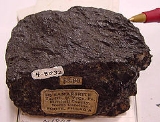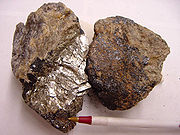
Samarskite
Encyclopedia
Samarskite is a radioactive rare earth mineral series which includes
samarskite-(Y) with formula: (YFe3+Fe2+U,Th,Ca)2(Nb,Ta)2O8
and samarskite-(Yb) with formula (YbFe3+)2(Nb,Ta)2O8 The formula for smarskite-(Y) is also given as: (Y,Fe3+,U)(Nb,Ta)O4
Samarskite crystallizes in the orthorhombic - dipyramidal class as black to yellowish brown stubby prisms although it is typically found as anhedral
masses. Specimens with a high uranium content are typically metamict and appear coated with a yellow brown earthy rind.
Samarskite occurs in rare earth bearing granite
pegmatite
s with other rare minerals. It occurs in association with columbite
, zircon
, monazite
, uraninite
, aeschynite
, magnetite
, albite
, topaz
, beryl
, garnet
, muscovite
and biotite
.
Samarskite was first described in 1847 for an occurrence in Miass
, Ilmen Mountains, Southern Ural Mountains
of Russia
. The chemical element samarium
was first isolated from a specimen of samarskite in 1879. Samarium was named after samarskite which was named for the Russian mine official, Colonel Vasili Samarsky-Bykhovets
(1803–1870).
Samarskite-(Yb) was first described in 2004 for an occurrence in the South Platte Pegmatite District, Jefferson County, Colorado
.

samarskite-(Y) with formula: (YFe3+Fe2+U,Th,Ca)2(Nb,Ta)2O8
and samarskite-(Yb) with formula (YbFe3+)2(Nb,Ta)2O8 The formula for smarskite-(Y) is also given as: (Y,Fe3+,U)(Nb,Ta)O4
Samarskite crystallizes in the orthorhombic - dipyramidal class as black to yellowish brown stubby prisms although it is typically found as anhedral
Anhedral (petrology)
A rock with an anhedral texture is composed of mineral grains that have no well formed crystal faces or cross-section shape in thin section. Anhedral crystal growth occurs in a competitive environment with no free space for the formation of crystal faces. An intermediate texture with some crystal...
masses. Specimens with a high uranium content are typically metamict and appear coated with a yellow brown earthy rind.
Samarskite occurs in rare earth bearing granite
Granite
Granite is a common and widely occurring type of intrusive, felsic, igneous rock. Granite usually has a medium- to coarse-grained texture. Occasionally some individual crystals are larger than the groundmass, in which case the texture is known as porphyritic. A granitic rock with a porphyritic...
pegmatite
Pegmatite
A pegmatite is a very crystalline, intrusive igneous rock composed of interlocking crystals usually larger than 2.5 cm in size; such rocks are referred to as pegmatitic....
s with other rare minerals. It occurs in association with columbite
Columbite
Columbite, also called niobite, niobite-tantalite and columbate [2O6], is a black mineral group that is an ore of niobium and tantalum. It has a submetallic luster and a high density and is a niobate of iron and manganese, containing tantalate of iron. This mineral group was first found in Haddam,...
, zircon
Zircon
Zircon is a mineral belonging to the group of nesosilicates. Its chemical name is zirconium silicate and its corresponding chemical formula is ZrSiO4. A common empirical formula showing some of the range of substitution in zircon is 1–x4x–y...
, monazite
Monazite
Monazite is a reddish-brown phosphate mineral containing rare earth metals. It occurs usually in small isolated crystals. There are actually at least four different kinds of monazite, depending on relative elemental composition of the mineral:...
, uraninite
Uraninite
Uraninite is a radioactive, uranium-rich mineral and ore with a chemical composition that is largely UO2, but also contains UO3 and oxides of lead, thorium, and rare earth elements...
, aeschynite
Aeschynite-(Y)
Aeschynite- is a rare earth mineral of yttrium, calcium, iron, thorium, titanium, niobium, oxygen, and hydrogen with formula: 26. Its name comes from the Greek word for "shame". Its Mohs scale rating is 5 to 6.-References:**...
, magnetite
Magnetite
Magnetite is a ferrimagnetic mineral with chemical formula Fe3O4, one of several iron oxides and a member of the spinel group. The chemical IUPAC name is iron oxide and the common chemical name is ferrous-ferric oxide. The formula for magnetite may also be written as FeO·Fe2O3, which is one part...
, albite
Albite
Albite is a plagioclase feldspar mineral. It is the sodium endmember of the plagioclase solid solution series. As such it represents a plagioclase with less than 10% anorthite content. The pure albite endmember has the formula NaAlSi3O8. It is a tectosilicate. Its color is usually pure white, hence...
, topaz
Topaz
Topaz is a silicate mineral of aluminium and fluorine with the chemical formula Al2SiO42. Topaz crystallizes in the orthorhombic system and its crystals are mostly prismatic terminated by pyramidal and other faces.-Color and varieties:...
, beryl
Beryl
The mineral beryl is a beryllium aluminium cyclosilicate with the chemical formula Be3Al26. The hexagonal crystals of beryl may be very small or range to several meters in size. Terminated crystals are relatively rare...
, garnet
Garnet
The garnet group includes a group of minerals that have been used since the Bronze Age as gemstones and abrasives. The name "garnet" may come from either the Middle English word gernet meaning 'dark red', or the Latin granatus , possibly a reference to the Punica granatum , a plant with red seeds...
, muscovite
Muscovite
Muscovite is a phyllosilicate mineral of aluminium and potassium with formula KAl22, or 236. It has a highly-perfect basal cleavage yielding remarkably-thin laminæ which are often highly elastic...
and biotite
Biotite
Biotite is a common phyllosilicate mineral within the mica group, with the approximate chemical formula . More generally, it refers to the dark mica series, primarily a solid-solution series between the iron-endmember annite, and the magnesium-endmember phlogopite; more aluminous endmembers...
.
Samarskite was first described in 1847 for an occurrence in Miass
Miass
Miass is a city in Chelyabinsk Oblast, Russia, located west of Chelyabinsk, on the eastern slope of the southern Urals, on the bank of the Miass River. Population: -History:...
, Ilmen Mountains, Southern Ural Mountains
Ural Mountains
The Ural Mountains , or simply the Urals, are a mountain range that runs approximately from north to south through western Russia, from the coast of the Arctic Ocean to the Ural River and northwestern Kazakhstan. Their eastern side is usually considered the natural boundary between Europe and Asia...
of Russia
Russia
Russia or , officially known as both Russia and the Russian Federation , is a country in northern Eurasia. It is a federal semi-presidential republic, comprising 83 federal subjects...
. The chemical element samarium
Samarium
Samarium is a chemical element with the symbol Sm, atomic number 62 and atomic weight 150.36. It is a moderately hard silvery metal which readily oxidizes in air. Being a typical member of the lanthanide series, samarium usually assumes the oxidation state +3...
was first isolated from a specimen of samarskite in 1879. Samarium was named after samarskite which was named for the Russian mine official, Colonel Vasili Samarsky-Bykhovets
Vasili Samarsky-Bykhovets
Vasili Evgrafovich Samarsky–Bykhovets was a Russian mining engineer and the chief of Russian Mining Engineering Corps between 1845 and 1861. The mineral samarskite and chemical element samarium are named after him...
(1803–1870).
Samarskite-(Yb) was first described in 2004 for an occurrence in the South Platte Pegmatite District, Jefferson County, Colorado
Jefferson County, Colorado
Jefferson County , whose slogan is the "Gateway to the Rocky Mountains", is the fourth most populous of the 64 counties of the State of Colorado of the United States. Located along the Front Range of the Rocky Mountains, Jefferson County is adjacent to the west side of the state capital, Denver....
.


